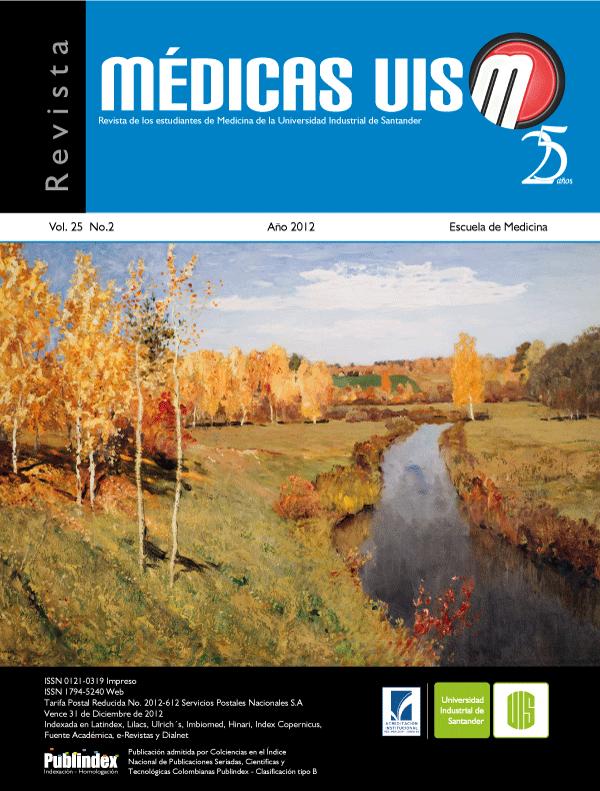Abstract
Introduction: scientific societies have studied indications for blood transfusion and have designed clinical practice guidelines to avoid unnecessary transfusions and optimize the use of donated blood units. Some researches have found that these guidelines aren’t followed as expected. Objective: compare transfusion practices of a Hospital level II in Colombia with the suggestions of international guidelines. Materials and methods: using the records of Transfusion Medicine Center of the Hospital, the transfusions made between July 14th and November 30th of 2010 were analyzed, we obtained information about the causes of transfusion, type of blood component ordered, the specialty of the ordering physician and the concordance with clinical practice guidelines of the American Association of Blood Banks, the American Red Cross, and the American Society of Anesthesiologists. We got facts about the percentage of properly ordered transfusions compared with the total of transfusions. Results: most of transfusions were ordered by general doctors who showed the best adherence to clinical practice guidelines. The first cause of transfusion was anemia and the blood component more requested was red cell units. The percentage of inadequate transfusions was 25.5%. Conclusions: transfusion practice must be improved adapting to published guidelines. Consequently, a transfusion medical committee must be created in every hospital as well as protocols must be written. Reviewing the literature, we found that some aspects of the guidelines could change in the future, like the use of plasma in cases of massive bleeding. (MÉD.UIS. 2012;25(2):107-12).
References
2. Nuttall GA, Stehling LC, Beighley CM, Faust RJ; American Society of Anesthesiologists Committee on Transfusion Medicine. Current transfusion practices of members of the american society of anesthesiologists:a survey. Anesthesiology. 2003;99:1433-43.
3. American Society of Anesthesiologists Task Force on Perioperative Blood Transfusion and adjuvant therapies. Practice guidelines for perioperative blood transfusion and adjuvant therapies: an updated report by the American Society of Anesthesiologists Task Force on Perioperative Blood Transfusion and Adjuvant Therapies. Anesthesiology. 2006;105:198–208.
4. Meléndez HJ, Zambrano M, Martínez X. Evaluación de adecuada indicación transfusional en un hospital universitario. Rev Col Anest. 2007;35:195-201.
5. Cable R, Carlson B, Chambers L, Kolins J, Murphy S, Tilzer L, et al. Practice guidelines for blood transfusion: a compilation from recent peer-reviewed literature [Internet]. 2 ed. American red cross; 2007 [citado 2011 Nov 21]. Disponible en: http://www.sld.cu/galerias/pdf/sitios/anestesiologia/practical_guidelines_blood_transfusion.pdf.
6. American Association of Blood Banks. Standards for blood banks and transfusions services. 20th ed. Bethesda, Maryland: AABB press; 1999.
7. Kumar A. Perioperative management of anemia: Limits of blood transfusion and alternatives to it. Cleve Clin J Med. 2009;76 Suppl 4:112-8.
8. Rivera D, Pérez A. Técnicas de ahorro sanguíneo en cirugía. Rev Col Anest. 2011 nov - 2012 ene;39:545-59.
9. Carson JL, Duff A, Berlin JA, Lawrence VA, Poses RM, Huber EC, et al. Perioperative blood transfusion and postoperative mortality. JAMA. 1998;279:199-205.
10. Goodnough LT, Shander A, Spivak JL, Waters JH, Friedman AJ, Carson JL, et al. Detection, evaluation, and management of anemia in the elective surgical patient. Anesth Analg. 2005;101:1858-61.
11. Leichtle SW, Mouawad NJ, Lampman R, Singal B, Cleary RK. Does preoperative anemia adversely affect colon and rectal surgery outcomes?. J Am Coll Surg. 2011;212:187-94.
12. Wu WC, Schifftner TL, Henderson WG, Eaton CB, Poses RM, Uttley G, et al. Preoperative hematocrit levels and postoperative outcomes in older patients undergoing noncardiac surgery. JAMA. 2007;297:2481-8.
13. Llau JV, Basora M, Gómez A, Moral V. Tratado de medicina transfusional perioperatoria. Barcelona: Elsevier; 2010. pp. 509.
14. Alexander JM, Sarode R, McIntire DD, Burner JD, Leveno KJ. Whole Blood in the management of hypovolemia due to obstetric hemorrhage. Obstet Gynecol. 2009;113:1320-6.
15. Wilson K, MacDougall L, Fergusson D, Graham I, Tinmouth A, Hebert PC. The effectiveness of interventions to reduce physician’s levels of inappropriate transfusion: what can be learned from a systematic review of the literature. Transfusion. 2002;42:1224-9.
16. Carson JL, Grossman BJ, Kleinman S, Tinmouth AT, Marques MB, Fung MK, et al. Red Blood Cell Transfusion: a Clinical Practice Guideline From the AABB. First published March 26, 2012 on annals.org. Disponible en www.annals.org/content/early/2012/03/26/0003-4819-156-12-201206190-00429.full
